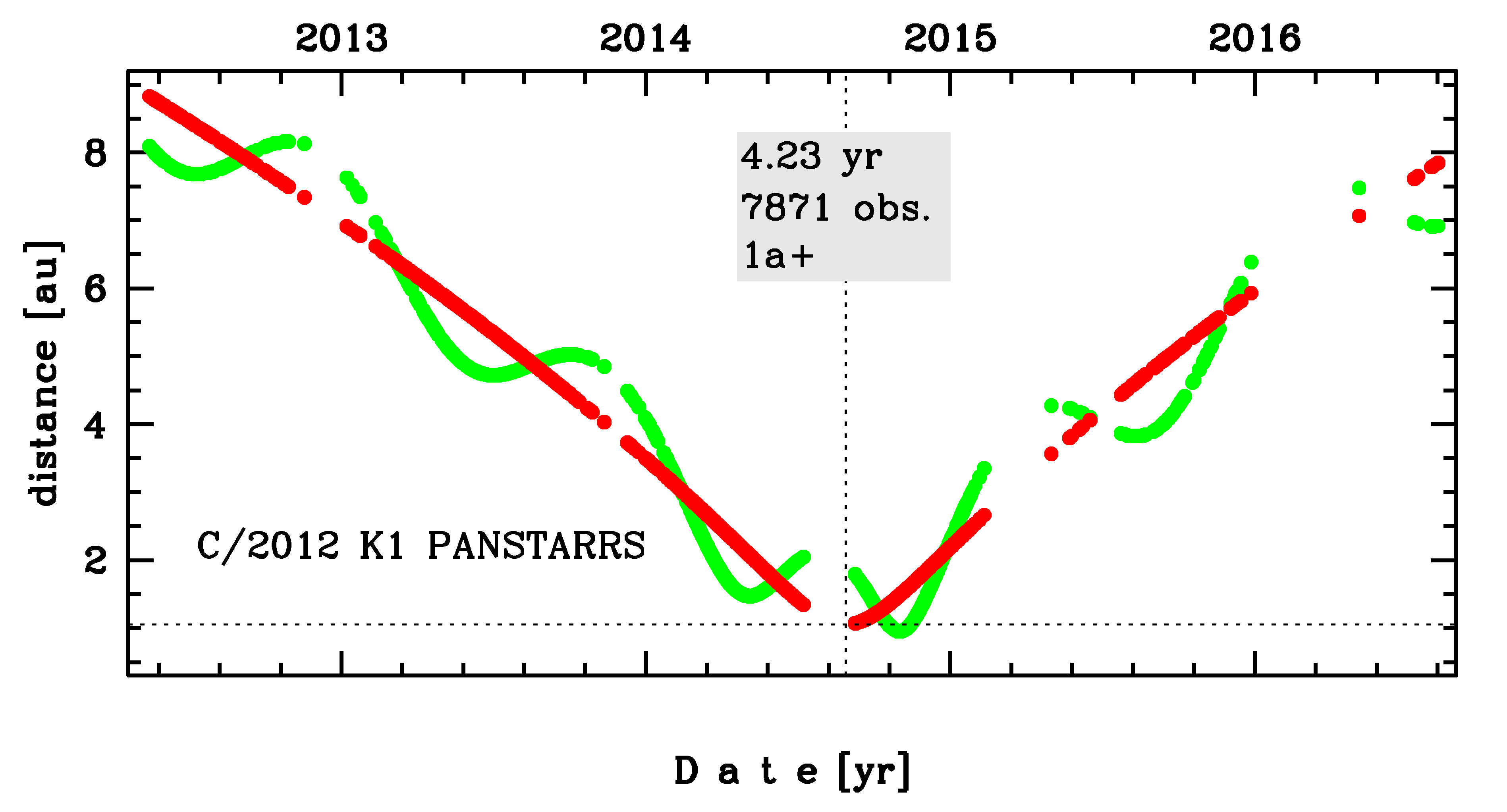C/2012 K1 PANSTARRS
more info
Comet C/2012 K1 was discovered on 19 May 2012 with Pan-STARRS 1 telescope (Haleakala), that is more than 2 years before its perihelion passage. Later a few pre-discovery images were found taken on 14 May ( MASTER-II Observatory, Tunka) and 17 May (Pan-STARRS 1). It was almost systematically observed until 7 August 2016 (see picture).
C/2012 K1 had its closest approach to the Earth on 31 October 2014 (0.953 au), about 2 months after its perihelion passage.
Preferred solution given here is based on data spanning over 4.23 yr in a range of heliocentric distances: 8.83 au – 1.055 au (perihelion) – 7.85 au.
This Oort spike comet suffers small planetary perturbations during its passage through the planetary system that cause a bit tighter future orbit (see future barycentric orbits).
See also Królikowska 2020.
C/2012 K1 had its closest approach to the Earth on 31 October 2014 (0.953 au), about 2 months after its perihelion passage.
Preferred solution given here is based on data spanning over 4.23 yr in a range of heliocentric distances: 8.83 au – 1.055 au (perihelion) – 7.85 au.
This Oort spike comet suffers small planetary perturbations during its passage through the planetary system that cause a bit tighter future orbit (see future barycentric orbits).
See also Królikowska 2020.
| solution description | ||
|---|---|---|
| number of observations | 7871 | |
| data interval | 2012 05 14 – 2016 08 07 | |
| data type | perihelion within the observation arc (FULL) | |
| data arc selection | entire data set (STD) | |
| range of heliocentric distances | 8.83 au – 1.05 au (perihelion) – 7.85 au | |
| type of model of motion | NT - non-gravitational orbits for asymmetric, standard g(r) | |
| data weighting | YES | |
| number of residuals | 15569 | |
| RMS [arcseconds] | 0.34 | |
| orbit quality class | 1a+ | |
| previous orbit statistics, both Galactic and stellar perturbations were taken into account | ||
|---|---|---|
| no. of returning VCs in the swarm | 5001 | * |
| no. of escaping VCs in the swarm | 0 | |
| no. of hyperbolas among escaping VCs in the swarm | 0 | |
| previous reciprocal semi-major axis [10-6 au-1] | 39.29 – 39.41 – 39.76 | |
| previous perihelion distance [au] | 833 – 860 – 886 | |
| previous aphelion distance [103 au] | 49.47 – 49.89 – 50.03 | |
| time interval to previous perihelion [Myr] | 3.86 – 3.92 – 3.97 | |
| percentage of VCs with qprev > 20 | 100 | |
| previous_g orbit statistics, here only the Galactic tide has been included | ||
|---|---|---|
| no. of returning VCs in the swarm | 5001 | * |
| no. of escaping VCs in the swarm | 0 | |
| no. of hyperbolas among escaping VCs in the swarm | 0 | |
| previous reciprocal semi-major axis [10-6 au-1] | 39.96 – 40.31 – 40.66 | |
| previous perihelion distance [au] | 0.217 – 0.239 – 0.265 | |
| previous aphelion distance [103 au] | 49.19 – 49.61 – 50.05 | |
| time interval to previous perihelion [Myr] | 3.85 – 3.9 – 3.96 | |
| percentage of VCs with qprev < 10 | 100 | |
